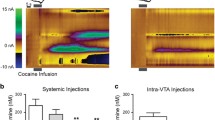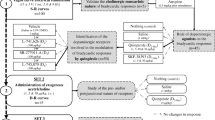Abstract
Clonidine (0.1 mg/kg IP)-induced hypoactivity and mydriasis responses were respectively used as functional indices of pre- and postsynaptic α2-adrenoceptors in mouse brain. A single injection of various antidepressant drugs had no effect on either response when measured 24 h later. However, 14 days' treatment with sibutramine HCl (3 mg/kg IP), dothiepin (50 mg/kg IP), amitriptyline (10 mg/kg IP), desipramine (10 mg/kg IP) or tranylcypromine (10 mg/kg IP) markedly attenuated both clonidine-induced hypoactivity and mydriasis. Repeated administration of zimeldine (10 mg/kg IP), mianserin (10 mg/kg IP) or clenbuterol (5 mg/kg IP) had no effect on either response. Subchronic treatment with sibutramine HCl (3 mg/kg IP; 3 days) also attenuated pre- and postsynaptic α2-adrenoceptor function. Five ECS (200 V, 2 s) spread over 10 days, but not a single shock, reduced the hypoactivity and mydriasis responses to clonidine. Together, the results indicate that pre- and postsynaptic α2-adrenoceptor function is attenuated by repeated treatment with those antidepressants which acutely increase synaptic levels of noradrenaline. These adrenergic receptor populations are also desensitized by ECS, although this effect is probably mediated via a different mechanism. Finally, the rapid down-regulation observed with sibutramine HCl is not confined toβ-adrenoceptors alone, because pre- and postsynaptic α2-adrenoceptor function is also attenuated by 3 days of treatment with this novel antidepressant drug.
Similar content being viewed by others
References
Armitage P (1971) Statistical methods in medical research. Blackwell, Oxford
Asakura M, Tsukamoto T, Hasagawa K (1982) Modulation of rat brain α2- andβ-adrenoceptor sensitivity following long-term treatment with antidepressants. Brain Res 235:192–197
Bergstrom DA, Kellar KJ (1979a) Adrenergic and serotonergic receptor binding in rat brain after chronic desmethylimipramine treatment. J Pharmacol Exp Ther 209:256–261
Bergstrom DA, Kellar KJ (1979b) Effect of electroconvulsive shock on monoaminergic receptor binding sites in rat brain. Nature 278: 464–466
Berridge TL, Gadie B, Roach AG, Tulloch IF (1983) α-Adrenoceptor agonists induce mydriasis in the rat by an action within the central nervous system. Br J Pharmacol 78:507–515
Buckett WR, Thomas PC, Luscombe GP (1988) The pharmacology of sibutramine hydrochloride (BTS 54 524), a new antidepressant which induces rapid noradrenergic down-regulation. Prog Neuropsychopharmacol Biol Psychiatry 12:575–584
Dausse JP, Le Quan-Bui KH, Meyer P (1982) α1-and α2-Adrenoceptors in rat cerebral cortex: effects of neonatal treatment with 6-hydroxydopamine. Eur J Pharmacol 78:15–20
Dooley DJ, Bittiger H (1987) Quantitative assessment of centralβ 1-andβ 2-adrenoceptor regulation using CGP 20712A. J Pharmacol Methods 18:131–136
Dooley DJ, Bittiger H, Hauser KL, Bischoff SF, Waldmeier PC (1983) Alteration of central alpha2- and beta-adrenergic receptors in the rat after DSP-4, a selective noradrenergic neurotoxin. Neuroscience 9:889–898
Dooley DJ, Heal DJ, Goodwin GM (1987) Repeated electroconvulsive shock prevents increased neocorticalβ 1-adrenoceptor binding after DSP-4 treatment in rats. Eur J Pharmacol 134:333–337
Drew GM, Gower AJ, Marriott AS (1979) α2-Adrenoceptors mediate clonidine-induced sedation in the rat. Br J Pharmacol 67:133–141
Dunnett CW (1964) New tables for multiple comparisons with a control. Biometrics 20:482–491
Green AR, Heal DJ, Vincent ND (1987) The effects of single and repeated electroconvulsive shock administration on the release of 5-hydroxytryptamine and noradrenaline from cortical slices of rat brain. Br J Pharmacol 92:25–30
Heal DJ, Akagi H, Bowdler JM, Green AR (1981) Repeated electroconvulsive shock attenuates clonidine-induced hypoactivity in rodents. Eur J Pharmacol 75:231–237
Heal DJ, Lister S, Smith SL, Davies CL, Molyneux SG, Green AR (1983) The effects of acute and repeated administration of various antidepressant drugs on clonidine-induced hypoactivity in mice and rats. Neuropharmacology 22:983–992
Heal DJ, Bristow LJ, Elliott JM, Bloomfield JG, Catto LC, Atterwill CK (1987) The influence of L-triiodothyronine (T3) on the effects of repeated administration of desipramine or electroconvulsive shock on α2- andβ-adrenoceptor function in the rat: implications for the potentiation of antidepressant therapy by T3. Neuropharmacology 26:1131–1139
Heal DJ, Prow MR, Buckett WR (1989a) Measurement of 3-methoxy-4-hydroxyphenylglycol (MHPG) in mouse brain by h.p.l.c. with electrochemical detection as an index of noradrenaline utilisation and presynaptic α2-adrenoceptor function. Br J Pharmacol 96:547–556
Heal DJ, Prow MR, Buckett WR (1989b) Clonidine produces mydriasis in conscious mice by activating central α2-adrenoceptors. Eur J Pharmacol 170:11–18
Heal DJ, Prow MR, Buckett WR (1989c) Clonidine-induced hypoactivity and mydriasis in mice are respectively mediated via pre- and postsynaptic α2-adrenoceptors in the brain. Eur J Pharmacol 170:19–29
Heal DJ, Butler SA, Hurst EM, Buckett WR (1989d) Antidepressant treatments, including sibutramine hydrochloride and electroconvulsive shock, decreaseβ 1-but notβ 2-adrenoceptors in rat cortex. J Neurochem 53:1019–1025
Heal DJ, Bristow LM, Hurst EM, Elliott JM, Buckett WR (1989e) Sex-related differences in central adrenergic function and responsiveness to repeated administration of desipramine or electroconvulsive shock. Br J Pharmacol 97:111–118
Hey JA, Gherezghiher T, Koss MC (1985) Studies on the mechanism of clonidine-induced mydriasis in the rat. Naunyn-Schmiedeberg's Arch Pharmacol 328:258–263
Hollander M, Wolfe DA (1973) Nonparametric statistical methods. Wiley, New York
Johnson RW, Reisine T, Spotnitz S, Weich N, Ursillo R, Yamamura HI (1980) Effects of desipramine and yohimbine on α2-andβ-adrenoceptor sensitivity. Eur J Pharmacol 67:123–127
Koss MC (1979) Clonidine mydriasis in the cat. Further evidence for a CNS postsynaptic action. Naunyn-Schmiedeberg's Arch Pharmacol 309:235–239
Koss MC, Christensen HD (1979) Evidence for a central postsynaptic action of clonidine. Naunyn-Schmiedeberg's Arch Pharmacol 307:45–50
Koss MC, Gherezghiher T, Nomura A (1984) CNS adrenergic inhibition of parasympathetic oculomotor tone. J Auton Nerv Syst 10:55–68
Langer SZ (1981) Presynaptic regulation of the release of catecholamines. Pharmacol Rev 32:337–362
Maggi A, U'Prichard DC, Enna SJ (1980) Differential effects of antidepressant treatment on brain monoaminergic receptors. Eur J Pharmacol 61:91–98
McMillen BA, Warnack W, German DC, Shore PA (1980) Effects of chronic desipramine treatment on rat brain noradrenergic responses to α-adrenergic drugs. Eur J Pharmacol 61:239–246
McWilliam JR, Campbell IC (1987) Effects of antidepressant drug treatments on α2-adrenoceptor control of [3H]noradrenaline release from hypothalamic synaptosomes. J Neurochem 49:163–168
Minchin MCW, Williams J, Bowdler JM, Green AR (1983) The effect of electroconvulsive shock on the uptake and release of noradrenaline and 5-hydroxytryptamine in rat brain slices. J Neurochem 40:765–768
Minneman KP, Dibner MD, Wolfe BB, Molinoff PB (1979)β 1-andβ 2-adrenergic receptors in rat cerebral cortex are independently regulated. Science 204:866–868
Miyauchi T, Kitada Y, Satoh S (1982) Effect of acute and chronic treatment with tricyclic antidepressants on 3-methoxy-4-hydroxyphenylethyleneglycol sulfate (MHPG-SO4) contents in various regions of rat brain. Prog Neuropsychopharmacol Biol Psychiatry 6:137–142
Nassif S, Kempf E, Cardo B, Velley L (1983) Neurochemical lesion of the locus coeruleus of the rat does not suppress the sedative effect of clonidine. Eur J Pharmacol 91:69–76
Nimgaonkar VL, Heal DJ, Davies CL, Green AR (1986) Studies on rat brain catecholamine synthesis andβ-adrenoceptor number following administration of electroconvulsive shock, desipramine and clenbuterol. J Neural Transm 65:245–259
Nomura YK, Oki K, Segawa T (1980) Pharmacological characterization of central α-adrenoceptors which mediate clonidine-induced locomotor hypoactivity in the developing rat. Naunyn-Schmiedeberg's Arch Pharmacol 311:41–44
Paykel ES, Hale AS (1986) Recent advances in the treatment of depression. In: Deakin JFW (ed) The biology of depression. Gaskell, London, pp 153–173
Payvandi N, Elliott JM, Heal DJ (1990) Radioligand binding to presynaptic α2-adrenoceptors in rat cortex revealed by short-term DSP-4 lesioning. Br J Pharmacol (in press)
Pilc A, Vetulani J (1982) Depression by chronic electroconvulsive treatment of clonidine hypothermia and [3H]clonidine binding to rat cortical membranes. Eur J Pharmacol 80:109–113
Sharpe LG, Pickworth WB (1981) Pupillary dilation after microinjections of morphine, normorphine and clonidine into the Edinger-Westphal nucleus (EW) in the cat. Neurosci Abstr 7:609
Simon P, Lecrubier Y, Jouvent R, Peuch A, Widlocher D (1984) Beta-receptor stimulation in the treatment of depression. In: Usdin E, Asberg M, Bertilsson L and Sjöqvist F (eds) Frontiers in biochemical and pharmacological research in depression. Raven Press, New York, p 293
Smith CB, Garcia-Sevilla JA, Hollingsworth PJ (1981) α2-Adrenoceptors in rat brain are decreased after long-term tricyclic antidepressant drug treatment. Brain Res 210:413–418
Spyraki C, Fibiger HC (1982) Clonidine-induced sedation in rats: evidence for mediation by postsynaptic α2-adrenoceptors. J Neural Transm 54:153–163
Stanford SC, Nutt DJ (1982) Comparison of the effects of repeated electroconvulsive shock on α2- andβ-adrenoceptors in different regions of rat brain. Neuroscience 7:1753–1757
Stanford SC, Nutt DJ, Cowen PJ (1983) Comparison of the effects of chronic desmethylimipramine administration on α2- andβ-adrenoceptors in different regions of rat brain. Neuroscience 8:161–164
Sugrue MF (1983) Some effects of chronic antidepressant treatments on rat brain monoaminergic systems. J Neural Transm 57:281–295
Tang SW, Helmeste DM, Stancer HC (1978) The effect of acute and chronic desipramine and amitriptyline treatment on rat brain total 3-methoxy-4-hydroxyphenylglycol. Naunyn-Schmiedeberg's Arch Pharmacol 305:207–211
Tang SW, Helmeste DM, Stancer HC (1979) Interaction of antidepressants with clonidine on rat brain total 3-methoxy-4-hydroxyphenylglycol. Can J Physiol Pharmacol 57:435–437
U'Prichard DC, Reisine TD, Mason ST, Fibiger HC, Yamamura HI (1980) Modulation of rat brain α- andβ-adrenergic receptor populations by lesion of the dorsal noradrenergic bundle. Brain Res 187:143–154
Vetulani J (1982) Adaptive changes as the mode of action of antidepressant treatments. In: Costa E, Racagni G (eds) Typical and atypical antidepressants: molecular mechanisms. Raven Press, New York, pp 27–36
Vetulani J, Antkiewicz-Michaluk L (1985) Alpha-adrenergic receptor changes during antidepressant treatment. Acta Pharmacol Toxicol 56 (Suppl I): 55–65
Vetulani J, Stawarz RJ, Dingell JV, Sulser F (1976) A possible common mechanism of action of antidepressant treatments. Naunyn-Schmiedeberg's Arch Pharmacol 293:109–114
Zebrowska-Lupina I, Przegalinski E, Sloniec M, Kleinrock K (1977) Clonidine induced locomotor hyperactivity in rats. The role of postsynaptic α-adrenoceptors. Naunyn-Schmiedeberg's Arch Pharmacol 297:227–231
Author information
Authors and Affiliations
Rights and permissions
About this article
Cite this article
Heal, D.J., Prow, M.R. & Buckett, W.R. Effects of antidepressant drugs and electroconvulsive shock on pre- and postsynaptic α2-adrenoceptor function in the brain: rapid down-regulation by sibutramine hydrochloride. Psychopharmacology 103, 251–257 (1991). https://doi.org/10.1007/BF02244212
Received:
Accepted:
Issue Date:
DOI: https://doi.org/10.1007/BF02244212




